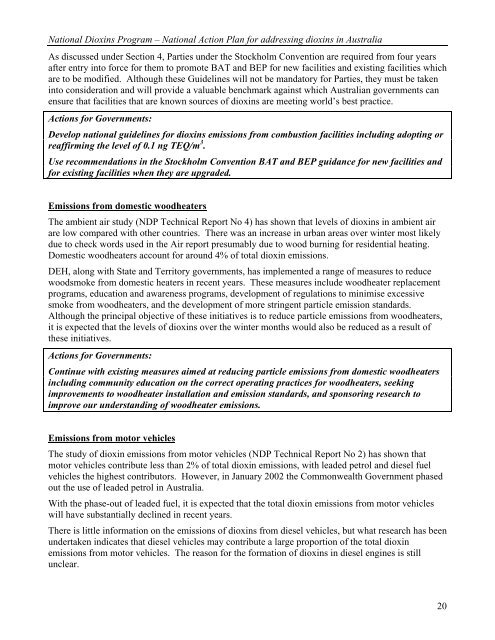National Action Plan for Addressing Dioxins in Australia
National Action Plan for Addressing Dioxins in Australia
National Action Plan for Addressing Dioxins in Australia
- No tags were found...
You also want an ePaper? Increase the reach of your titles
YUMPU automatically turns print PDFs into web optimized ePapers that Google loves.
<strong>National</strong> <strong>Diox<strong>in</strong>s</strong> Program – <strong>National</strong> <strong>Action</strong> <strong>Plan</strong> <strong>for</strong> address<strong>in</strong>g diox<strong>in</strong>s <strong>in</strong> <strong>Australia</strong>As discussed under Section 4, Parties under the Stockholm Convention are required from four yearsafter entry <strong>in</strong>to <strong>for</strong>ce <strong>for</strong> them to promote BAT and BEP <strong>for</strong> new facilities and exist<strong>in</strong>g facilities whichare to be modified. Although these Guidel<strong>in</strong>es will not be mandatory <strong>for</strong> Parties, they must be taken<strong>in</strong>to consideration and will provide a valuable benchmark aga<strong>in</strong>st which <strong>Australia</strong>n governments canensure that facilities that are known sources of diox<strong>in</strong>s are meet<strong>in</strong>g world’s best practice.<strong>Action</strong>s <strong>for</strong> Governments:Develop national guidel<strong>in</strong>es <strong>for</strong> diox<strong>in</strong>s emissions from combustion facilities <strong>in</strong>clud<strong>in</strong>g adopt<strong>in</strong>g orreaffirm<strong>in</strong>g the level of 0.1 ng TEQ/m 3 .Use recommendations <strong>in</strong> the Stockholm Convention BAT and BEP guidance <strong>for</strong> new facilities and<strong>for</strong> exist<strong>in</strong>g facilities when they are upgraded.Emissions from domestic woodheatersThe ambient air study (NDP Technical Report No 4) has shown that levels of diox<strong>in</strong>s <strong>in</strong> ambient airare low compared with other countries. There was an <strong>in</strong>crease <strong>in</strong> urban areas over w<strong>in</strong>ter most likelydue to check words used <strong>in</strong> the Air report presumably due to wood burn<strong>in</strong>g <strong>for</strong> residential heat<strong>in</strong>g.Domestic woodheaters account <strong>for</strong> around 4% of total diox<strong>in</strong> emissions.DEH, along with State and Territory governments, has implemented a range of measures to reducewoodsmoke from domestic heaters <strong>in</strong> recent years. These measures <strong>in</strong>clude woodheater replacementprograms, education and awareness programs, development of regulations to m<strong>in</strong>imise excessivesmoke from woodheaters, and the development of more str<strong>in</strong>gent particle emission standards.Although the pr<strong>in</strong>cipal objective of these <strong>in</strong>itiatives is to reduce particle emissions from woodheaters,it is expected that the levels of diox<strong>in</strong>s over the w<strong>in</strong>ter months would also be reduced as a result ofthese <strong>in</strong>itiatives.<strong>Action</strong>s <strong>for</strong> Governments:Cont<strong>in</strong>ue with exist<strong>in</strong>g measures aimed at reduc<strong>in</strong>g particle emissions from domestic woodheaters<strong>in</strong>clud<strong>in</strong>g community education on the correct operat<strong>in</strong>g practices <strong>for</strong> woodheaters, seek<strong>in</strong>gimprovements to woodheater <strong>in</strong>stallation and emission standards, and sponsor<strong>in</strong>g research toimprove our understand<strong>in</strong>g of woodheater emissions.Emissions from motor vehiclesThe study of diox<strong>in</strong> emissions from motor vehicles (NDP Technical Report No 2) has shown thatmotor vehicles contribute less than 2% of total diox<strong>in</strong> emissions, with leaded petrol and diesel fuelvehicles the highest contributors. However, <strong>in</strong> January 2002 the Commonwealth Government phasedout the use of leaded petrol <strong>in</strong> <strong>Australia</strong>.With the phase-out of leaded fuel, it is expected that the total diox<strong>in</strong> emissions from motor vehicleswill have substantially decl<strong>in</strong>ed <strong>in</strong> recent years.There is little <strong>in</strong><strong>for</strong>mation on the emissions of diox<strong>in</strong>s from diesel vehicles, but what research has beenundertaken <strong>in</strong>dicates that diesel vehicles may contribute a large proportion of the total diox<strong>in</strong>emissions from motor vehicles. The reason <strong>for</strong> the <strong>for</strong>mation of diox<strong>in</strong>s <strong>in</strong> diesel eng<strong>in</strong>es is stillunclear.20
















